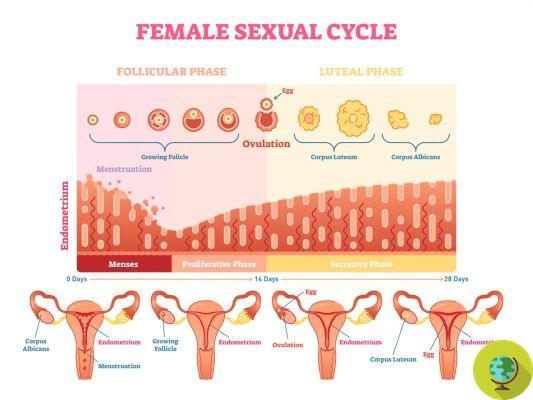
Menstrual cycle, let's find out what are its phases, duration and symptoms that herald the arrival of menstruation. The arrival of the first menstrual cycle marks the beginning of the fertile period for a woman.
Menstrual cycle, let's find out what are its phases, the duration and the symptoms that herald the arrival of Menses. The arrival of the first period marks the beginning of the fertile period for a woman.
The series of menstrual cycles usually begins around the age of 11 and continues until menopause, which occurs around the age of 50, although much depends on personal, family and genetic factors. We speak of precocious puberty when the menstrual cycle occurs in young girls, only 8 years old.
The changes related to the phases of the menstrual cycle are due to the production of different hormones by our body. We can describe the menstrual cycle as a sequence of periodic physiological changes that serve the maturation of the egg cell, ready for fertilization, and for the preparation of a tissue suitable for its implantation.
Index
Duration of the menstrual cycle
The standard duration of the menstrual cycle is equal to 28 days, but women may have shorter cycles (of 24, 25 or 26 days) or slightly longer (up to 32 days). If your period occurs at more or less frequent intervals than normal, this could be a sign of a problem. Better to consult your doctor and gynecologist.
Stages of the menstrual cycle
If we take as a reference a menstrual cycle lasting 28 days, we can outline the different ones phases as follows:
1) Follicular phase
From 1st to 5th day: menstruation appears, the endometrium flakes off.
From 6th to 13th day: a follicle matures in the ovary, the endometrium is rebuilt.
2) Ovulation
On day 14, the ovaries release an egg cell, also called a female ovum, oocyte or gamete.
3) Lutein phase
From the 15th to the 21st day the corpus luteum is formed, the endometrium thickens and develops.
(For further information see Cecie Starr, “Biology, concepts and applications”, Garzanti).
Ovulation and fertile days
It is interesting to know that during ovulation each month a mature egg is released ready to be fertilized and that the ovaries alternate from month to month for carrying out this task. The release of the ovum by the ovaries is favored by the production ofLH hormone.
Just at the 14th day of the cycle (in a regular 28 day menstrual cycle), thepituitary gland increases the production of the LH hormone. In reality it must be taken into account that both the egg and the sperm retain their ability to fertilize for about 72 hours. For this reason, we don't usually talk about a single fertile day during the menstrual cycle, but at least 2 or 3 days (with some exceptions).
Symptoms of the menstrual cycle
Among the symptoms of the onset of menstruation we may find small leaks, headaches, breast tension, back pain, weakness, dizziness, abdominal pain, discomfort in the kidneys or ovaries and a swollen belly, just to name a few of the more common conditions. common, which can persist even during the days of actual menstruation. Some women suffer from menstrual cramps with severe abdominal pain.
Natural remedies for painful menstruation
Sufferers painful menstruation may have recourse to some natural remedies. We had already talked about natural remedies to relieve them, among which we find essential oils, aromatherapy, healing ointments, relaxing herbal teas, foot baths and application of compresses. THU more information on natural remedies to relieve menstrual pain. You can learn more about the subject by contacting your doctor and your trusted herbalist.
Marta Albè
Read also:
Menstrual pains: 10 natural remedies to relieve them
How to reduce menstrual pain with natural remedies
Natural remedies and therapies for cycle disorders and menopause


























